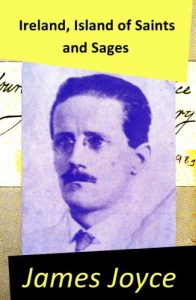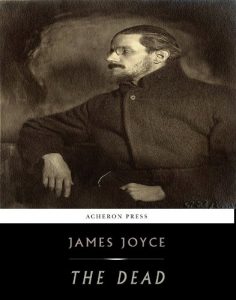The Dead
It is now approaching one hundred years since the first publication of The Dead and this wonderful story continues to fascinate readers, even prompting in recent times a film adaptation and a stage play. There are many who feel it is the finest short story/novella ever written. Beautifully executed in so many ways, multilayered and possessing an ineffable delicateness in subtlety throughout, it may indeed be James Joyce’s finest writing. There is something so captivating in the way The Dead unfolds that even peripheral characters such as Lily the caretaker’s daughter, Miss Ivors and Bartell D’Arcy take on a very definite existence and linger with the reader taken through this tale of tussle between the living and the dead.
Critical interest in the story has remained active with scholars still debating the meaning of the title, still searching out the meaning of Gabriel’s ‘journey westward’, and continuing identifying thematic significances. One fact that there is unanimity upon is that Gabriel Conroy is James Joyce—and the twenty-five year-old James Joyce writing the story in Trieste in the spring and summer of 1907 is harsh on himself: ‘A shameful consciousness of his own person assailed him. He saw himself as a ludicrous figure, acting as a pennyboy for his aunts, a nervous well-meaning sentimentalist, orating to vulgarians and idealising his own clownish lusts, the pitiable fatuous fellow he had caught a glimpse of in the mirror. Instinctively he turned his back more to the light lest she might see the shame that burned upon his forehead.’
The ending of the story where Gabriel looks out the window of his room in the Gresham Hotel and watches the snow — ‘His soul swooned slowly as he heard the snow falling faintly through the universe and faintly falling, like the descent of their last end, upon all the living and the dead.’ — is quite unforgettable.
Many editions in several languages have been published. The latest (edited and generously and informatively annotated by James Mulligan) is a lavishly illustrated book that contains fifty-nine monochrome and color illustrations of the contemporary Dublin. Some of the illustrations such as the two photos of the legendary opera singer mentioned in the story, William Parkinson, and an illustration of the famous English soprano, Georgina Burns, are seen for the first time.
It is now approaching one hundred years since the first publication of The Dead and this wonderful story continues to fascinate readers, even prompting in recent times a film adaptation and a stage play. There are many who feel it is the finest short story/novella ever written. Beautifully executed in so many ways, multilayered and possessing an ineffable delicateness in subtlety throughout, it may indeed be James Joyce’s finest writing. There is something so captivating in the way The Dead unfolds that even peripheral characters such as Lily the caretaker’s daughter, Miss Ivors and Bartell D’Arcy take on a very definite existence and linger with the reader taken through this tale of tussle between the living and the dead.
Critical interest in the story has remained active with scholars still debating the meaning of the title, still searching out the meaning of Gabriel’s ‘journey westward’, and continuing identifying thematic significances. One fact that there is unanimity upon is that Gabriel Conroy is James Joyce—and the twenty-five year-old James Joyce writing the story in Trieste in the spring and summer of 1907 is harsh on himself: ‘A shameful consciousness of his own person assailed him. He saw himself as a ludicrous figure, acting as a pennyboy for his aunts, a nervous well-meaning sentimentalist, orating to vulgarians and idealising his own clownish lusts, the pitiable fatuous fellow he had caught a glimpse of in the mirror. Instinctively he turned his back more to the light lest she might see the shame that burned upon his forehead.’
The ending of the story where Gabriel looks out the window of his room in the Gresham Hotel and watches the snow — ‘His soul swooned slowly as he heard the snow falling faintly through the universe and faintly falling, like the descent of their last end, upon all the living and the dead.’ — is quite unforgettable.
Many editions in several languages have been published. The latest (edited and generously and informatively annotated by James Mulligan) is a lavishly illustrated book that contains fifty-nine monochrome and color illustrations of the contemporary Dublin. Some of the illustrations such as the two photos of the legendary opera singer mentioned in the story, William Parkinson, and an illustration of the famous English soprano, Georgina Burns, are seen for the first time.






![Baixar The James Joyce Collection [Annotated] (English Edition) pdf, epub, eBook](https://br.99ebooks.net/wp-content/uploads/2017/05/41yY8X2Btk8L-221x300.jpg)





